BSc (Hons) Business Management BMP3002: Business Types Analysis Report
VerifiedAdded on 2022/12/23
|9
|2664
|41
Report
AI Summary
This report, prepared for a BSc (Hons) Business Management course, provides a comprehensive overview of various business types and structures. It begins by defining different company sizes, including micro, small, medium, and large businesses, and then delves into the characteristics of sole traders, partnerships, limited liability businesses, public limited liability businesses, and cooperatives. The report further explores organizational structures, specifically functional and divisional structures, and their impact on business productivity. Additionally, it applies PESTLE analysis to examine how political, economic, social, technological, legal, and environmental factors influence business performance, using examples from the UK market. The conclusion highlights the importance of understanding these factors for business success.
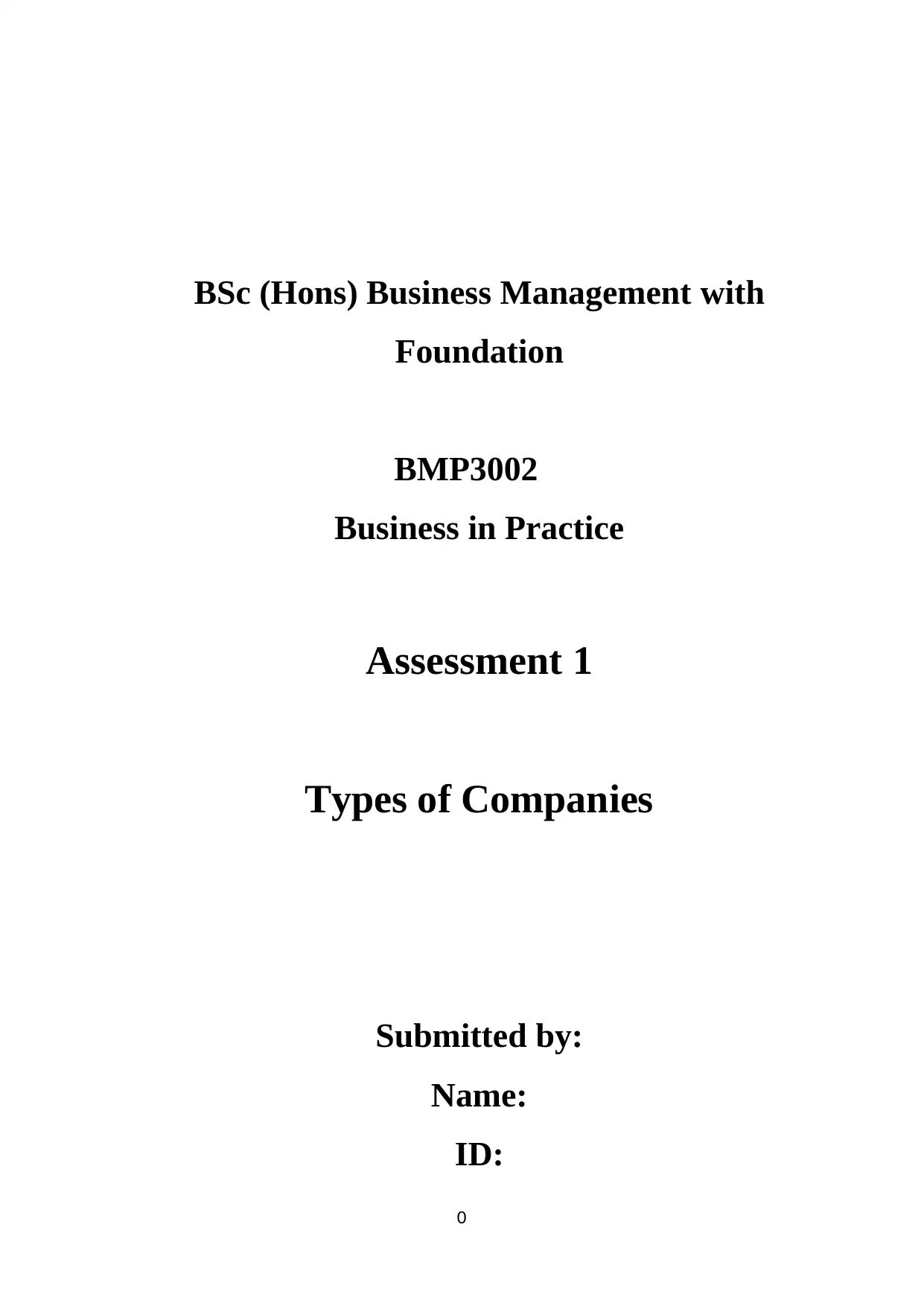
BSc (Hons) Business Management with
Foundation
BMP3002
Business in Practice
Assessment 1
Types of Companies
Submitted by:
Name:
ID:
0
Foundation
BMP3002
Business in Practice
Assessment 1
Types of Companies
Submitted by:
Name:
ID:
0
Paraphrase This Document
Need a fresh take? Get an instant paraphrase of this document with our AI Paraphraser
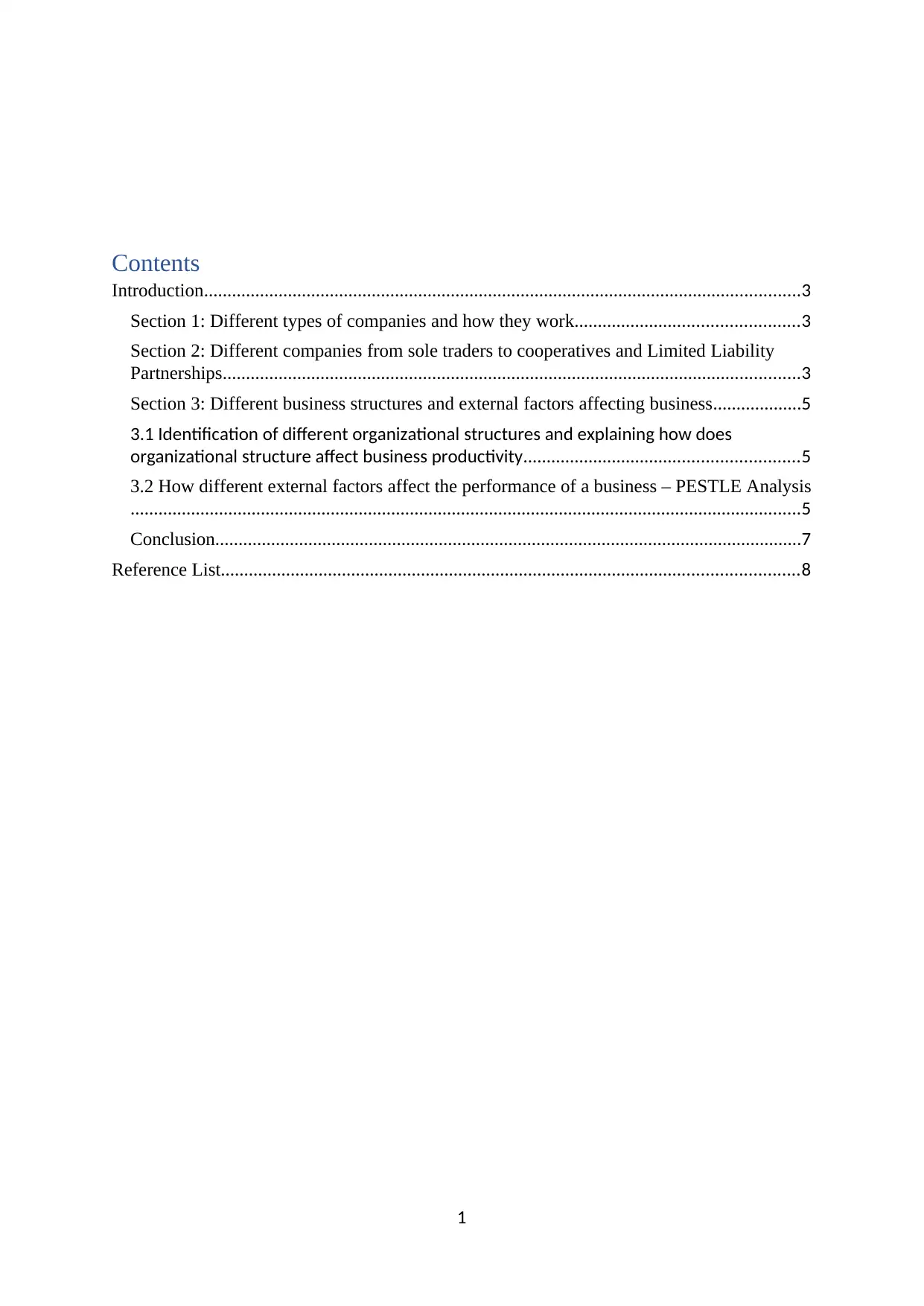
Contents
Introduction................................................................................................................................3
Section 1: Different types of companies and how they work................................................3
Section 2: Different companies from sole traders to cooperatives and Limited Liability
Partnerships............................................................................................................................3
Section 3: Different business structures and external factors affecting business...................5
3.1 Identification of different organizational structures and explaining how does
organizational structure affect business productivity...........................................................5
3.2 How different external factors affect the performance of a business – PESTLE Analysis
................................................................................................................................................5
Conclusion..............................................................................................................................7
Reference List............................................................................................................................8
1
Introduction................................................................................................................................3
Section 1: Different types of companies and how they work................................................3
Section 2: Different companies from sole traders to cooperatives and Limited Liability
Partnerships............................................................................................................................3
Section 3: Different business structures and external factors affecting business...................5
3.1 Identification of different organizational structures and explaining how does
organizational structure affect business productivity...........................................................5
3.2 How different external factors affect the performance of a business – PESTLE Analysis
................................................................................................................................................5
Conclusion..............................................................................................................................7
Reference List............................................................................................................................8
1

2
⊘ This is a preview!⊘
Do you want full access?
Subscribe today to unlock all pages.

Trusted by 1+ million students worldwide
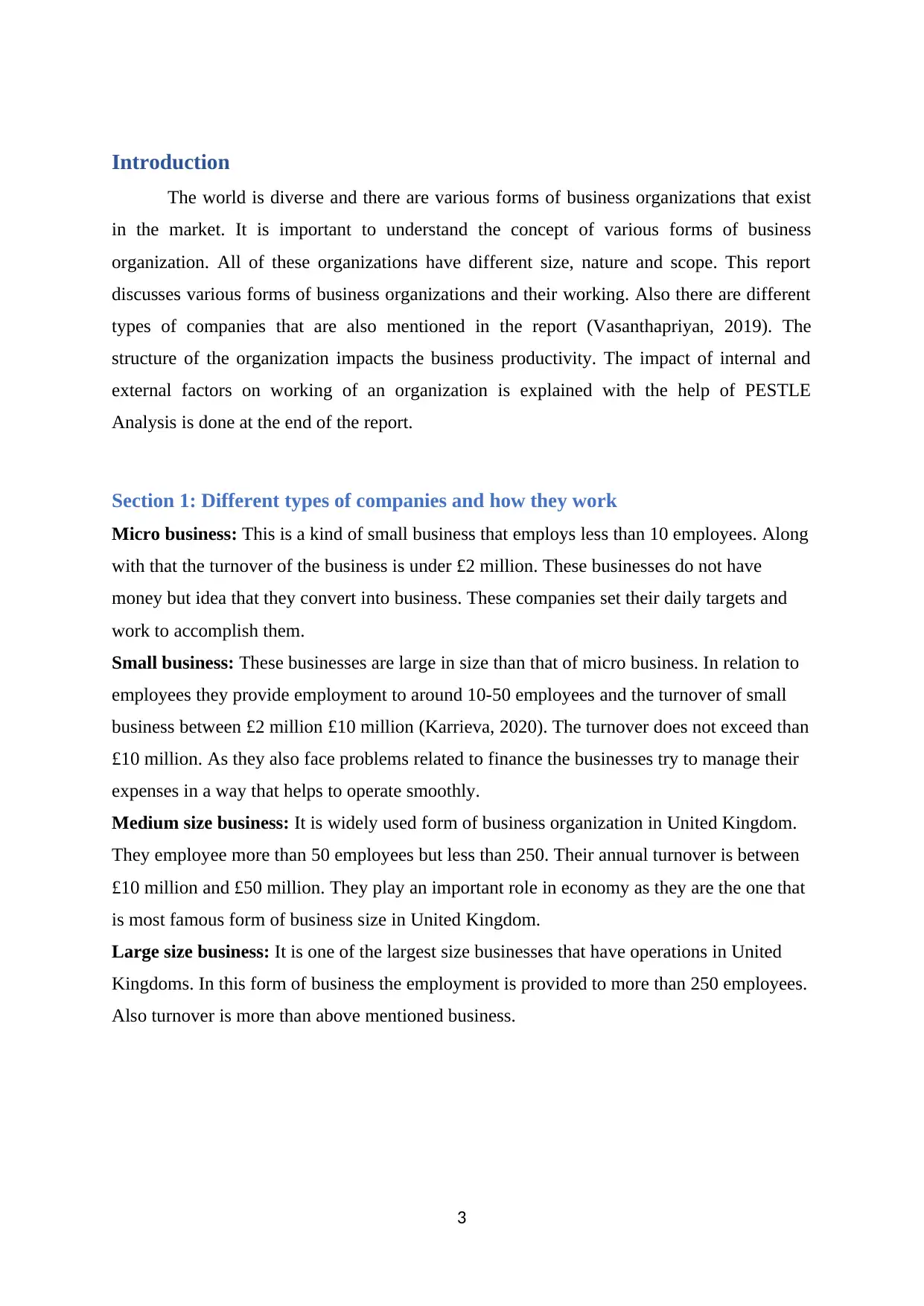
Introduction
The world is diverse and there are various forms of business organizations that exist
in the market. It is important to understand the concept of various forms of business
organization. All of these organizations have different size, nature and scope. This report
discusses various forms of business organizations and their working. Also there are different
types of companies that are also mentioned in the report (Vasanthapriyan, 2019). The
structure of the organization impacts the business productivity. The impact of internal and
external factors on working of an organization is explained with the help of PESTLE
Analysis is done at the end of the report.
Section 1: Different types of companies and how they work
Micro business: This is a kind of small business that employs less than 10 employees. Along
with that the turnover of the business is under £2 million. These businesses do not have
money but idea that they convert into business. These companies set their daily targets and
work to accomplish them.
Small business: These businesses are large in size than that of micro business. In relation to
employees they provide employment to around 10-50 employees and the turnover of small
business between £2 million £10 million (Karrieva, 2020). The turnover does not exceed than
£10 million. As they also face problems related to finance the businesses try to manage their
expenses in a way that helps to operate smoothly.
Medium size business: It is widely used form of business organization in United Kingdom.
They employee more than 50 employees but less than 250. Their annual turnover is between
£10 million and £50 million. They play an important role in economy as they are the one that
is most famous form of business size in United Kingdom.
Large size business: It is one of the largest size businesses that have operations in United
Kingdoms. In this form of business the employment is provided to more than 250 employees.
Also turnover is more than above mentioned business.
3
The world is diverse and there are various forms of business organizations that exist
in the market. It is important to understand the concept of various forms of business
organization. All of these organizations have different size, nature and scope. This report
discusses various forms of business organizations and their working. Also there are different
types of companies that are also mentioned in the report (Vasanthapriyan, 2019). The
structure of the organization impacts the business productivity. The impact of internal and
external factors on working of an organization is explained with the help of PESTLE
Analysis is done at the end of the report.
Section 1: Different types of companies and how they work
Micro business: This is a kind of small business that employs less than 10 employees. Along
with that the turnover of the business is under £2 million. These businesses do not have
money but idea that they convert into business. These companies set their daily targets and
work to accomplish them.
Small business: These businesses are large in size than that of micro business. In relation to
employees they provide employment to around 10-50 employees and the turnover of small
business between £2 million £10 million (Karrieva, 2020). The turnover does not exceed than
£10 million. As they also face problems related to finance the businesses try to manage their
expenses in a way that helps to operate smoothly.
Medium size business: It is widely used form of business organization in United Kingdom.
They employee more than 50 employees but less than 250. Their annual turnover is between
£10 million and £50 million. They play an important role in economy as they are the one that
is most famous form of business size in United Kingdom.
Large size business: It is one of the largest size businesses that have operations in United
Kingdoms. In this form of business the employment is provided to more than 250 employees.
Also turnover is more than above mentioned business.
3
Paraphrase This Document
Need a fresh take? Get an instant paraphrase of this document with our AI Paraphraser
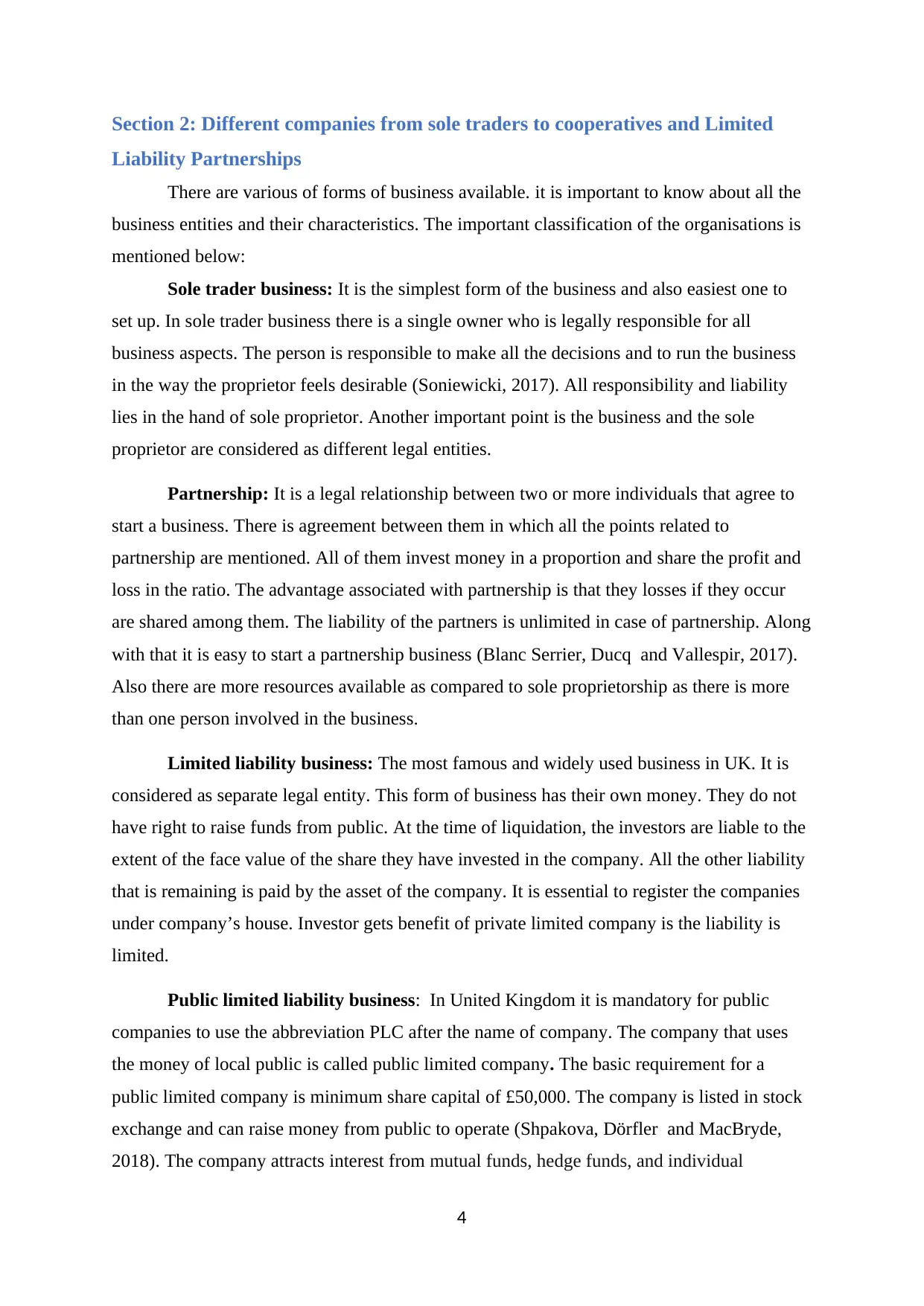
Section 2: Different companies from sole traders to cooperatives and Limited
Liability Partnerships
There are various of forms of business available. it is important to know about all the
business entities and their characteristics. The important classification of the organisations is
mentioned below:
Sole trader business: It is the simplest form of the business and also easiest one to
set up. In sole trader business there is a single owner who is legally responsible for all
business aspects. The person is responsible to make all the decisions and to run the business
in the way the proprietor feels desirable (Soniewicki, 2017). All responsibility and liability
lies in the hand of sole proprietor. Another important point is the business and the sole
proprietor are considered as different legal entities.
Partnership: It is a legal relationship between two or more individuals that agree to
start a business. There is agreement between them in which all the points related to
partnership are mentioned. All of them invest money in a proportion and share the profit and
loss in the ratio. The advantage associated with partnership is that they losses if they occur
are shared among them. The liability of the partners is unlimited in case of partnership. Along
with that it is easy to start a partnership business (Blanc Serrier, Ducq and Vallespir, 2017).
Also there are more resources available as compared to sole proprietorship as there is more
than one person involved in the business.
Limited liability business: The most famous and widely used business in UK. It is
considered as separate legal entity. This form of business has their own money. They do not
have right to raise funds from public. At the time of liquidation, the investors are liable to the
extent of the face value of the share they have invested in the company. All the other liability
that is remaining is paid by the asset of the company. It is essential to register the companies
under company’s house. Investor gets benefit of private limited company is the liability is
limited.
Public limited liability business: In United Kingdom it is mandatory for public
companies to use the abbreviation PLC after the name of company. The company that uses
the money of local public is called public limited company. The basic requirement for a
public limited company is minimum share capital of £50,000. The company is listed in stock
exchange and can raise money from public to operate (Shpakova, Dörfler and MacBryde,
2018). The company attracts interest from mutual funds, hedge funds, and individual
4
Liability Partnerships
There are various of forms of business available. it is important to know about all the
business entities and their characteristics. The important classification of the organisations is
mentioned below:
Sole trader business: It is the simplest form of the business and also easiest one to
set up. In sole trader business there is a single owner who is legally responsible for all
business aspects. The person is responsible to make all the decisions and to run the business
in the way the proprietor feels desirable (Soniewicki, 2017). All responsibility and liability
lies in the hand of sole proprietor. Another important point is the business and the sole
proprietor are considered as different legal entities.
Partnership: It is a legal relationship between two or more individuals that agree to
start a business. There is agreement between them in which all the points related to
partnership are mentioned. All of them invest money in a proportion and share the profit and
loss in the ratio. The advantage associated with partnership is that they losses if they occur
are shared among them. The liability of the partners is unlimited in case of partnership. Along
with that it is easy to start a partnership business (Blanc Serrier, Ducq and Vallespir, 2017).
Also there are more resources available as compared to sole proprietorship as there is more
than one person involved in the business.
Limited liability business: The most famous and widely used business in UK. It is
considered as separate legal entity. This form of business has their own money. They do not
have right to raise funds from public. At the time of liquidation, the investors are liable to the
extent of the face value of the share they have invested in the company. All the other liability
that is remaining is paid by the asset of the company. It is essential to register the companies
under company’s house. Investor gets benefit of private limited company is the liability is
limited.
Public limited liability business: In United Kingdom it is mandatory for public
companies to use the abbreviation PLC after the name of company. The company that uses
the money of local public is called public limited company. The basic requirement for a
public limited company is minimum share capital of £50,000. The company is listed in stock
exchange and can raise money from public to operate (Shpakova, Dörfler and MacBryde,
2018). The company attracts interest from mutual funds, hedge funds, and individual
4
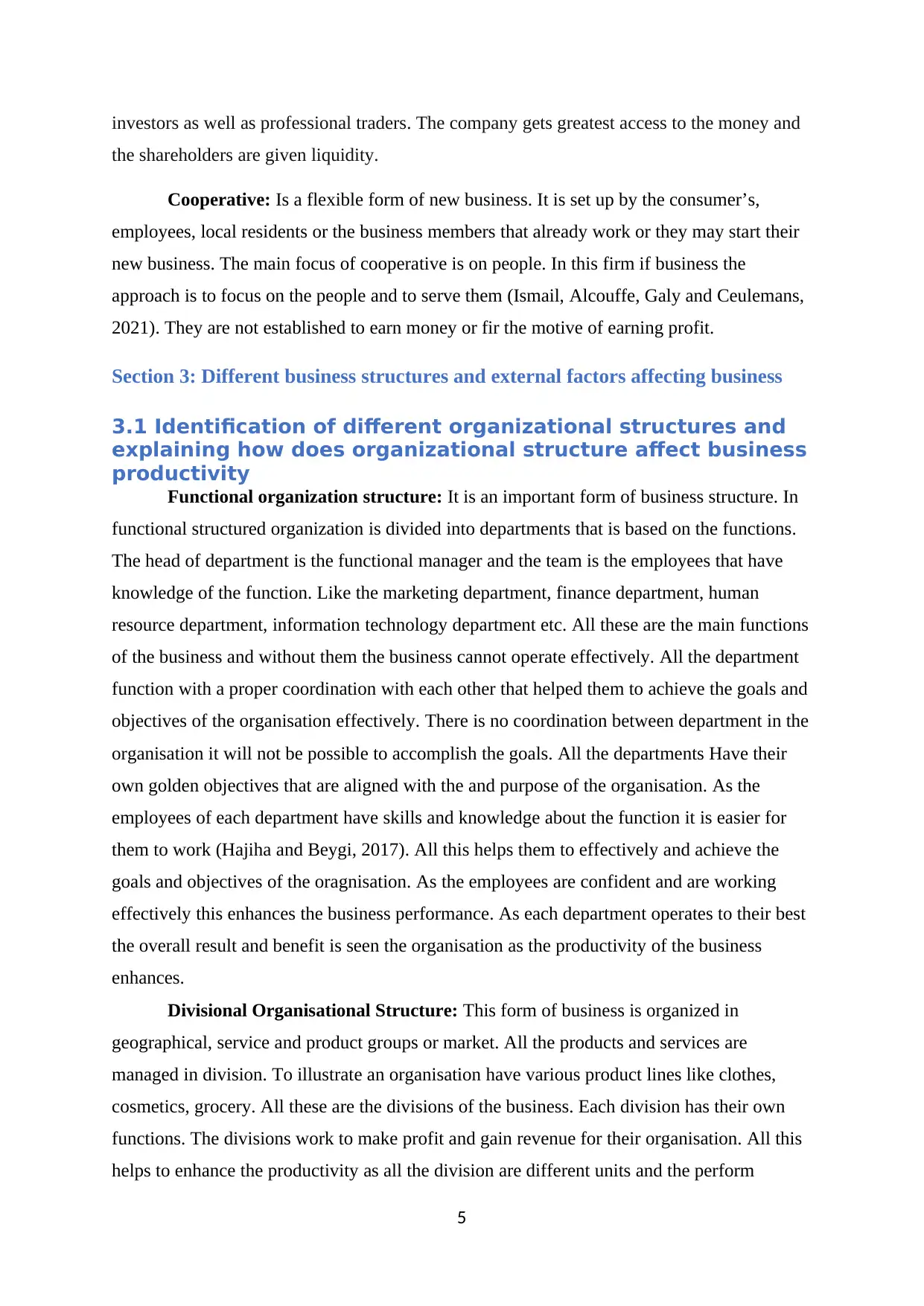
investors as well as professional traders. The company gets greatest access to the money and
the shareholders are given liquidity.
Cooperative: Is a flexible form of new business. It is set up by the consumer’s,
employees, local residents or the business members that already work or they may start their
new business. The main focus of cooperative is on people. In this firm if business the
approach is to focus on the people and to serve them (Ismail, Alcouffe, Galy and Ceulemans,
2021). They are not established to earn money or fir the motive of earning profit.
Section 3: Different business structures and external factors affecting business
3.1 Identification of different organizational structures and
explaining how does organizational structure affect business
productivity
Functional organization structure: It is an important form of business structure. In
functional structured organization is divided into departments that is based on the functions.
The head of department is the functional manager and the team is the employees that have
knowledge of the function. Like the marketing department, finance department, human
resource department, information technology department etc. All these are the main functions
of the business and without them the business cannot operate effectively. All the department
function with a proper coordination with each other that helped them to achieve the goals and
objectives of the organisation effectively. There is no coordination between department in the
organisation it will not be possible to accomplish the goals. All the departments Have their
own golden objectives that are aligned with the and purpose of the organisation. As the
employees of each department have skills and knowledge about the function it is easier for
them to work (Hajiha and Beygi, 2017). All this helps them to effectively and achieve the
goals and objectives of the oragnisation. As the employees are confident and are working
effectively this enhances the business performance. As each department operates to their best
the overall result and benefit is seen the organisation as the productivity of the business
enhances.
Divisional Organisational Structure: This form of business is organized in
geographical, service and product groups or market. All the products and services are
managed in division. To illustrate an organisation have various product lines like clothes,
cosmetics, grocery. All these are the divisions of the business. Each division has their own
functions. The divisions work to make profit and gain revenue for their organisation. All this
helps to enhance the productivity as all the division are different units and the perform
5
the shareholders are given liquidity.
Cooperative: Is a flexible form of new business. It is set up by the consumer’s,
employees, local residents or the business members that already work or they may start their
new business. The main focus of cooperative is on people. In this firm if business the
approach is to focus on the people and to serve them (Ismail, Alcouffe, Galy and Ceulemans,
2021). They are not established to earn money or fir the motive of earning profit.
Section 3: Different business structures and external factors affecting business
3.1 Identification of different organizational structures and
explaining how does organizational structure affect business
productivity
Functional organization structure: It is an important form of business structure. In
functional structured organization is divided into departments that is based on the functions.
The head of department is the functional manager and the team is the employees that have
knowledge of the function. Like the marketing department, finance department, human
resource department, information technology department etc. All these are the main functions
of the business and without them the business cannot operate effectively. All the department
function with a proper coordination with each other that helped them to achieve the goals and
objectives of the organisation effectively. There is no coordination between department in the
organisation it will not be possible to accomplish the goals. All the departments Have their
own golden objectives that are aligned with the and purpose of the organisation. As the
employees of each department have skills and knowledge about the function it is easier for
them to work (Hajiha and Beygi, 2017). All this helps them to effectively and achieve the
goals and objectives of the oragnisation. As the employees are confident and are working
effectively this enhances the business performance. As each department operates to their best
the overall result and benefit is seen the organisation as the productivity of the business
enhances.
Divisional Organisational Structure: This form of business is organized in
geographical, service and product groups or market. All the products and services are
managed in division. To illustrate an organisation have various product lines like clothes,
cosmetics, grocery. All these are the divisions of the business. Each division has their own
functions. The divisions work to make profit and gain revenue for their organisation. All this
helps to enhance the productivity as all the division are different units and the perform
5
⊘ This is a preview!⊘
Do you want full access?
Subscribe today to unlock all pages.

Trusted by 1+ million students worldwide
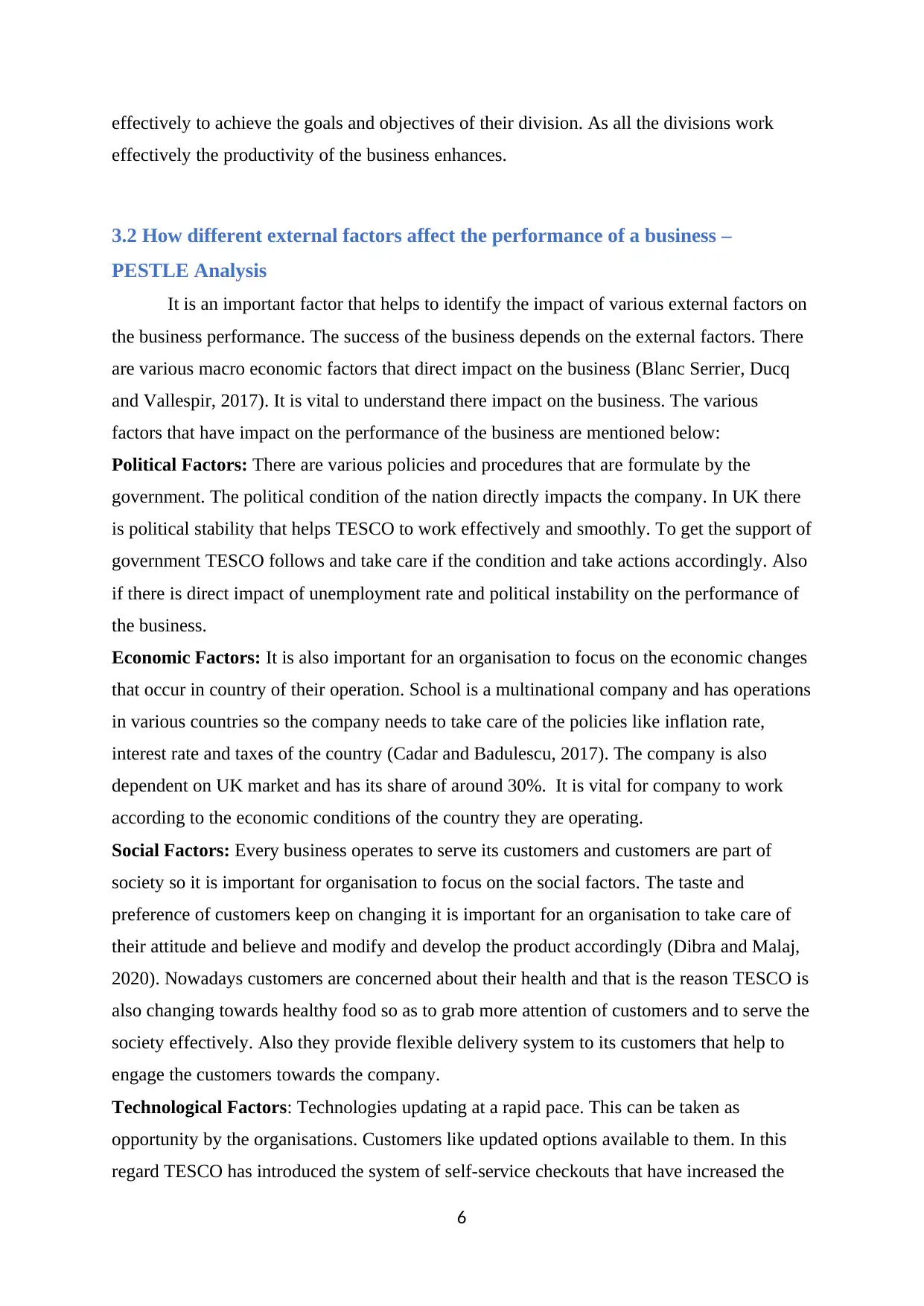
effectively to achieve the goals and objectives of their division. As all the divisions work
effectively the productivity of the business enhances.
3.2 How different external factors affect the performance of a business –
PESTLE Analysis
It is an important factor that helps to identify the impact of various external factors on
the business performance. The success of the business depends on the external factors. There
are various macro economic factors that direct impact on the business (Blanc Serrier, Ducq
and Vallespir, 2017). It is vital to understand there impact on the business. The various
factors that have impact on the performance of the business are mentioned below:
Political Factors: There are various policies and procedures that are formulate by the
government. The political condition of the nation directly impacts the company. In UK there
is political stability that helps TESCO to work effectively and smoothly. To get the support of
government TESCO follows and take care if the condition and take actions accordingly. Also
if there is direct impact of unemployment rate and political instability on the performance of
the business.
Economic Factors: It is also important for an organisation to focus on the economic changes
that occur in country of their operation. School is a multinational company and has operations
in various countries so the company needs to take care of the policies like inflation rate,
interest rate and taxes of the country (Cadar and Badulescu, 2017). The company is also
dependent on UK market and has its share of around 30%. It is vital for company to work
according to the economic conditions of the country they are operating.
Social Factors: Every business operates to serve its customers and customers are part of
society so it is important for organisation to focus on the social factors. The taste and
preference of customers keep on changing it is important for an organisation to take care of
their attitude and believe and modify and develop the product accordingly (Dibra and Malaj,
2020). Nowadays customers are concerned about their health and that is the reason TESCO is
also changing towards healthy food so as to grab more attention of customers and to serve the
society effectively. Also they provide flexible delivery system to its customers that help to
engage the customers towards the company.
Technological Factors: Technologies updating at a rapid pace. This can be taken as
opportunity by the organisations. Customers like updated options available to them. In this
regard TESCO has introduced the system of self-service checkouts that have increased the
6
effectively the productivity of the business enhances.
3.2 How different external factors affect the performance of a business –
PESTLE Analysis
It is an important factor that helps to identify the impact of various external factors on
the business performance. The success of the business depends on the external factors. There
are various macro economic factors that direct impact on the business (Blanc Serrier, Ducq
and Vallespir, 2017). It is vital to understand there impact on the business. The various
factors that have impact on the performance of the business are mentioned below:
Political Factors: There are various policies and procedures that are formulate by the
government. The political condition of the nation directly impacts the company. In UK there
is political stability that helps TESCO to work effectively and smoothly. To get the support of
government TESCO follows and take care if the condition and take actions accordingly. Also
if there is direct impact of unemployment rate and political instability on the performance of
the business.
Economic Factors: It is also important for an organisation to focus on the economic changes
that occur in country of their operation. School is a multinational company and has operations
in various countries so the company needs to take care of the policies like inflation rate,
interest rate and taxes of the country (Cadar and Badulescu, 2017). The company is also
dependent on UK market and has its share of around 30%. It is vital for company to work
according to the economic conditions of the country they are operating.
Social Factors: Every business operates to serve its customers and customers are part of
society so it is important for organisation to focus on the social factors. The taste and
preference of customers keep on changing it is important for an organisation to take care of
their attitude and believe and modify and develop the product accordingly (Dibra and Malaj,
2020). Nowadays customers are concerned about their health and that is the reason TESCO is
also changing towards healthy food so as to grab more attention of customers and to serve the
society effectively. Also they provide flexible delivery system to its customers that help to
engage the customers towards the company.
Technological Factors: Technologies updating at a rapid pace. This can be taken as
opportunity by the organisations. Customers like updated options available to them. In this
regard TESCO has introduced the system of self-service checkouts that have increased the
6
Paraphrase This Document
Need a fresh take? Get an instant paraphrase of this document with our AI Paraphraser
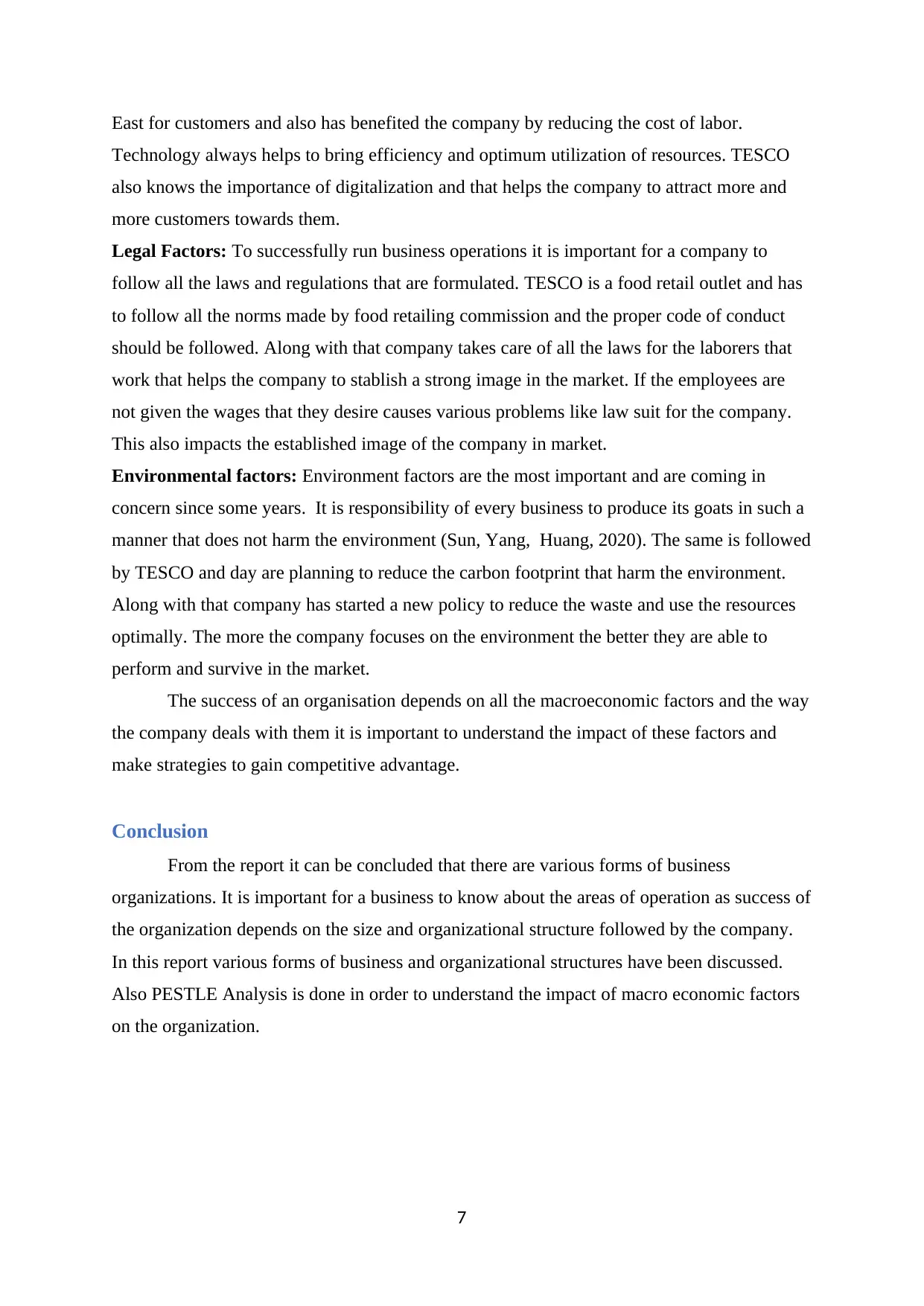
East for customers and also has benefited the company by reducing the cost of labor.
Technology always helps to bring efficiency and optimum utilization of resources. TESCO
also knows the importance of digitalization and that helps the company to attract more and
more customers towards them.
Legal Factors: To successfully run business operations it is important for a company to
follow all the laws and regulations that are formulated. TESCO is a food retail outlet and has
to follow all the norms made by food retailing commission and the proper code of conduct
should be followed. Along with that company takes care of all the laws for the laborers that
work that helps the company to stablish a strong image in the market. If the employees are
not given the wages that they desire causes various problems like law suit for the company.
This also impacts the established image of the company in market.
Environmental factors: Environment factors are the most important and are coming in
concern since some years. It is responsibility of every business to produce its goats in such a
manner that does not harm the environment (Sun, Yang, Huang, 2020). The same is followed
by TESCO and day are planning to reduce the carbon footprint that harm the environment.
Along with that company has started a new policy to reduce the waste and use the resources
optimally. The more the company focuses on the environment the better they are able to
perform and survive in the market.
The success of an organisation depends on all the macroeconomic factors and the way
the company deals with them it is important to understand the impact of these factors and
make strategies to gain competitive advantage.
Conclusion
From the report it can be concluded that there are various forms of business
organizations. It is important for a business to know about the areas of operation as success of
the organization depends on the size and organizational structure followed by the company.
In this report various forms of business and organizational structures have been discussed.
Also PESTLE Analysis is done in order to understand the impact of macro economic factors
on the organization.
7
Technology always helps to bring efficiency and optimum utilization of resources. TESCO
also knows the importance of digitalization and that helps the company to attract more and
more customers towards them.
Legal Factors: To successfully run business operations it is important for a company to
follow all the laws and regulations that are formulated. TESCO is a food retail outlet and has
to follow all the norms made by food retailing commission and the proper code of conduct
should be followed. Along with that company takes care of all the laws for the laborers that
work that helps the company to stablish a strong image in the market. If the employees are
not given the wages that they desire causes various problems like law suit for the company.
This also impacts the established image of the company in market.
Environmental factors: Environment factors are the most important and are coming in
concern since some years. It is responsibility of every business to produce its goats in such a
manner that does not harm the environment (Sun, Yang, Huang, 2020). The same is followed
by TESCO and day are planning to reduce the carbon footprint that harm the environment.
Along with that company has started a new policy to reduce the waste and use the resources
optimally. The more the company focuses on the environment the better they are able to
perform and survive in the market.
The success of an organisation depends on all the macroeconomic factors and the way
the company deals with them it is important to understand the impact of these factors and
make strategies to gain competitive advantage.
Conclusion
From the report it can be concluded that there are various forms of business
organizations. It is important for a business to know about the areas of operation as success of
the organization depends on the size and organizational structure followed by the company.
In this report various forms of business and organizational structures have been discussed.
Also PESTLE Analysis is done in order to understand the impact of macro economic factors
on the organization.
7
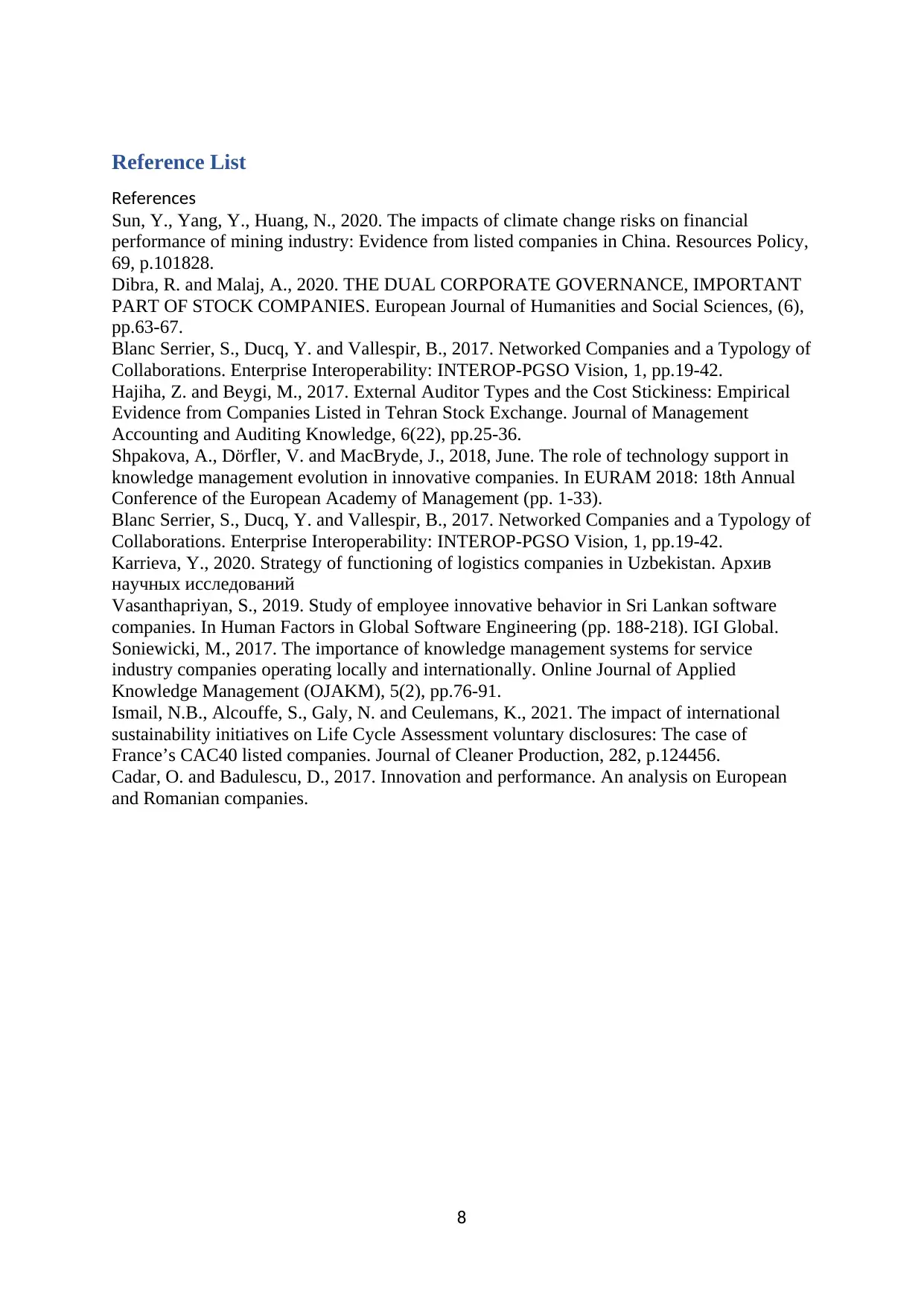
Reference List
References
Sun, Y., Yang, Y., Huang, N., 2020. The impacts of climate change risks on financial
performance of mining industry: Evidence from listed companies in China. Resources Policy,
69, p.101828.
Dibra, R. and Malaj, A., 2020. THE DUAL CORPORATE GOVERNANCE, IMPORTANT
PART OF STOCK COMPANIES. European Journal of Humanities and Social Sciences, (6),
pp.63-67.
Blanc Serrier, S., Ducq, Y. and Vallespir, B., 2017. Networked Companies and a Typology of
Collaborations. Enterprise Interoperability: INTEROP‐PGSO Vision, 1, pp.19-42.
Hajiha, Z. and Beygi, M., 2017. External Auditor Types and the Cost Stickiness: Empirical
Evidence from Companies Listed in Tehran Stock Exchange. Journal of Management
Accounting and Auditing Knowledge, 6(22), pp.25-36.
Shpakova, A., Dörfler, V. and MacBryde, J., 2018, June. The role of technology support in
knowledge management evolution in innovative companies. In EURAM 2018: 18th Annual
Conference of the European Academy of Management (pp. 1-33).
Blanc Serrier, S., Ducq, Y. and Vallespir, B., 2017. Networked Companies and a Typology of
Collaborations. Enterprise Interoperability: INTEROP‐PGSO Vision, 1, pp.19-42.
Karrieva, Y., 2020. Strategy of functioning of logistics companies in Uzbekistan. Архив
научных исследований
Vasanthapriyan, S., 2019. Study of employee innovative behavior in Sri Lankan software
companies. In Human Factors in Global Software Engineering (pp. 188-218). IGI Global.
Soniewicki, M., 2017. The importance of knowledge management systems for service
industry companies operating locally and internationally. Online Journal of Applied
Knowledge Management (OJAKM), 5(2), pp.76-91.
Ismail, N.B., Alcouffe, S., Galy, N. and Ceulemans, K., 2021. The impact of international
sustainability initiatives on Life Cycle Assessment voluntary disclosures: The case of
France’s CAC40 listed companies. Journal of Cleaner Production, 282, p.124456.
Cadar, O. and Badulescu, D., 2017. Innovation and performance. An analysis on European
and Romanian companies.
8
References
Sun, Y., Yang, Y., Huang, N., 2020. The impacts of climate change risks on financial
performance of mining industry: Evidence from listed companies in China. Resources Policy,
69, p.101828.
Dibra, R. and Malaj, A., 2020. THE DUAL CORPORATE GOVERNANCE, IMPORTANT
PART OF STOCK COMPANIES. European Journal of Humanities and Social Sciences, (6),
pp.63-67.
Blanc Serrier, S., Ducq, Y. and Vallespir, B., 2017. Networked Companies and a Typology of
Collaborations. Enterprise Interoperability: INTEROP‐PGSO Vision, 1, pp.19-42.
Hajiha, Z. and Beygi, M., 2017. External Auditor Types and the Cost Stickiness: Empirical
Evidence from Companies Listed in Tehran Stock Exchange. Journal of Management
Accounting and Auditing Knowledge, 6(22), pp.25-36.
Shpakova, A., Dörfler, V. and MacBryde, J., 2018, June. The role of technology support in
knowledge management evolution in innovative companies. In EURAM 2018: 18th Annual
Conference of the European Academy of Management (pp. 1-33).
Blanc Serrier, S., Ducq, Y. and Vallespir, B., 2017. Networked Companies and a Typology of
Collaborations. Enterprise Interoperability: INTEROP‐PGSO Vision, 1, pp.19-42.
Karrieva, Y., 2020. Strategy of functioning of logistics companies in Uzbekistan. Архив
научных исследований
Vasanthapriyan, S., 2019. Study of employee innovative behavior in Sri Lankan software
companies. In Human Factors in Global Software Engineering (pp. 188-218). IGI Global.
Soniewicki, M., 2017. The importance of knowledge management systems for service
industry companies operating locally and internationally. Online Journal of Applied
Knowledge Management (OJAKM), 5(2), pp.76-91.
Ismail, N.B., Alcouffe, S., Galy, N. and Ceulemans, K., 2021. The impact of international
sustainability initiatives on Life Cycle Assessment voluntary disclosures: The case of
France’s CAC40 listed companies. Journal of Cleaner Production, 282, p.124456.
Cadar, O. and Badulescu, D., 2017. Innovation and performance. An analysis on European
and Romanian companies.
8
⊘ This is a preview!⊘
Do you want full access?
Subscribe today to unlock all pages.

Trusted by 1+ million students worldwide
1 out of 9
Related Documents
Your All-in-One AI-Powered Toolkit for Academic Success.
+13062052269
info@desklib.com
Available 24*7 on WhatsApp / Email
![[object Object]](/_next/static/media/star-bottom.7253800d.svg)
Unlock your academic potential
Copyright © 2020–2025 A2Z Services. All Rights Reserved. Developed and managed by ZUCOL.




